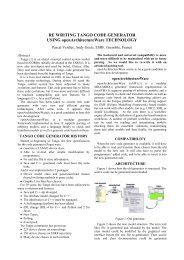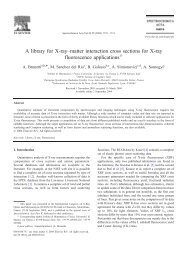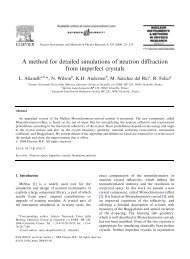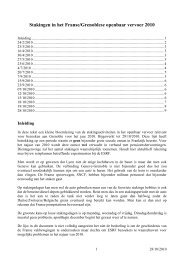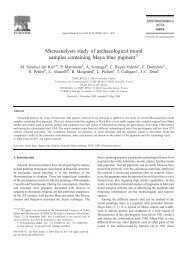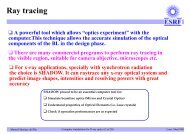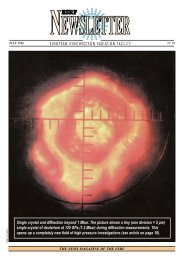Report on future detector requirements at ESRF
Report on future detector requirements at ESRF
Report on future detector requirements at ESRF
You also want an ePaper? Increase the reach of your titles
YUMPU automatically turns print PDFs into web optimized ePapers that Google loves.
Dynamic range:<br />
It is necessary to record the signal both before and after the absorpti<strong>on</strong> edge with a signal to<br />
noise r<strong>at</strong>io better than 10 3 , in order to detect correctly both pre-edge fe<strong>at</strong>ures and EXAFS<br />
oscill<strong>at</strong>i<strong>on</strong>s (with an amplitude down to 1% of the edge). After the edge, where the signal is<br />
the lowest, 10 6 phot<strong>on</strong>s/pixel are necessary to reach the required SNR of 10 3 .<br />
The intensity r<strong>at</strong>io Ibefore edge/Iafter edge can reach 1000 in the most absorbing samples (absorpti<strong>on</strong><br />
edge of 3 in the classical logarithmic represent<strong>at</strong>i<strong>on</strong>). Thus, the required dynamic range does<br />
not exceed 12 bits. Nevertheless, the sensitivity range of the <strong>detector</strong> must extend from<br />
10 6 phot<strong>on</strong>s/pixel (the lowest signals after edge, str<strong>on</strong>g absorpti<strong>on</strong> in sample and in sample<br />
envir<strong>on</strong>ment) up to more than 10 10 phot<strong>on</strong>s/pixel (for I0 measurement in the same acquisiti<strong>on</strong><br />
c<strong>on</strong>diti<strong>on</strong>s than the absorpti<strong>on</strong> spectrum).<br />
Linearity:<br />
For EXAFS, linearity is an important parameter, in particular for dichroism experiments, and<br />
the <strong>detector</strong> should be linear in the whole dynamic range.<br />
Flux <strong>on</strong> <strong>detector</strong>:<br />
The flux <strong>on</strong> <strong>detector</strong> is expected to be of the same order of magnitude as it is now <strong>on</strong> ID24 or<br />
<strong>at</strong> maximum multiplied by 3. Th<strong>at</strong> is 10 8 to 10 13 phot<strong>on</strong>s/s <strong>on</strong> the whole <strong>detector</strong>, depending<br />
<strong>on</strong> the sample and sample envir<strong>on</strong>ment absorpti<strong>on</strong>. Due to the energy profile given by the<br />
undul<strong>at</strong>or, the intensity is not distributed uniformly <strong>on</strong> the <strong>detector</strong>: central pixels receive<br />
around 50 times more phot<strong>on</strong>s than border pixels.<br />
It is worth notice th<strong>at</strong> good quality EXAFS spectra can be obtained with 50 integr<strong>at</strong>i<strong>on</strong>s of<br />
100 ps each in the 4-bunch mode and th<strong>at</strong> equivalent d<strong>at</strong>a are expected with integr<strong>at</strong>i<strong>on</strong> times<br />
of few µs in the uniform mode.<br />
Particular oper<strong>at</strong>ing c<strong>on</strong>diti<strong>on</strong>s:<br />
Direct detecti<strong>on</strong> would improve the overall efficiency of the system. In th<strong>at</strong> case, particular<br />
care should be taken c<strong>on</strong>cerning the radi<strong>at</strong>i<strong>on</strong> damage of the <strong>detector</strong>.<br />
Required <strong>detector</strong><br />
The needed <strong>detector</strong> is a 1D device with short integr<strong>at</strong>i<strong>on</strong> time and fast readout. The use of a<br />
1D streak camera is envisaged in order to observe phenomena occurring in the dur<strong>at</strong>i<strong>on</strong> of a<br />
phot<strong>on</strong> bunch in stroboscopic mode.<br />
Existing <strong>detector</strong>s<br />
ID24 is currently using a setup composed of a scintill<strong>at</strong>or, a diaphragm and a FReLoN CCD<br />
camera, reading <strong>on</strong>ly 32, 64 or 128 of the 2048 available lines.<br />
Short term possibilities<br />
A collabor<strong>at</strong>i<strong>on</strong> is envisaged with STFC in order to customise and use a fast Ge microstrip<br />
<strong>detector</strong>. In th<strong>at</strong> case, the sp<strong>at</strong>ial resoluti<strong>on</strong> of the <strong>detector</strong> has to be increased for the highest<br />
part of the energy range: charge sharing seems to deterior<strong>at</strong>e the resulting energy resoluti<strong>on</strong> of<br />
the spectra.<br />
Main required improvements<br />
The main expected improvement c<strong>on</strong>cerns the detecti<strong>on</strong> speed (integr<strong>at</strong>i<strong>on</strong> and readout times).<br />
28



